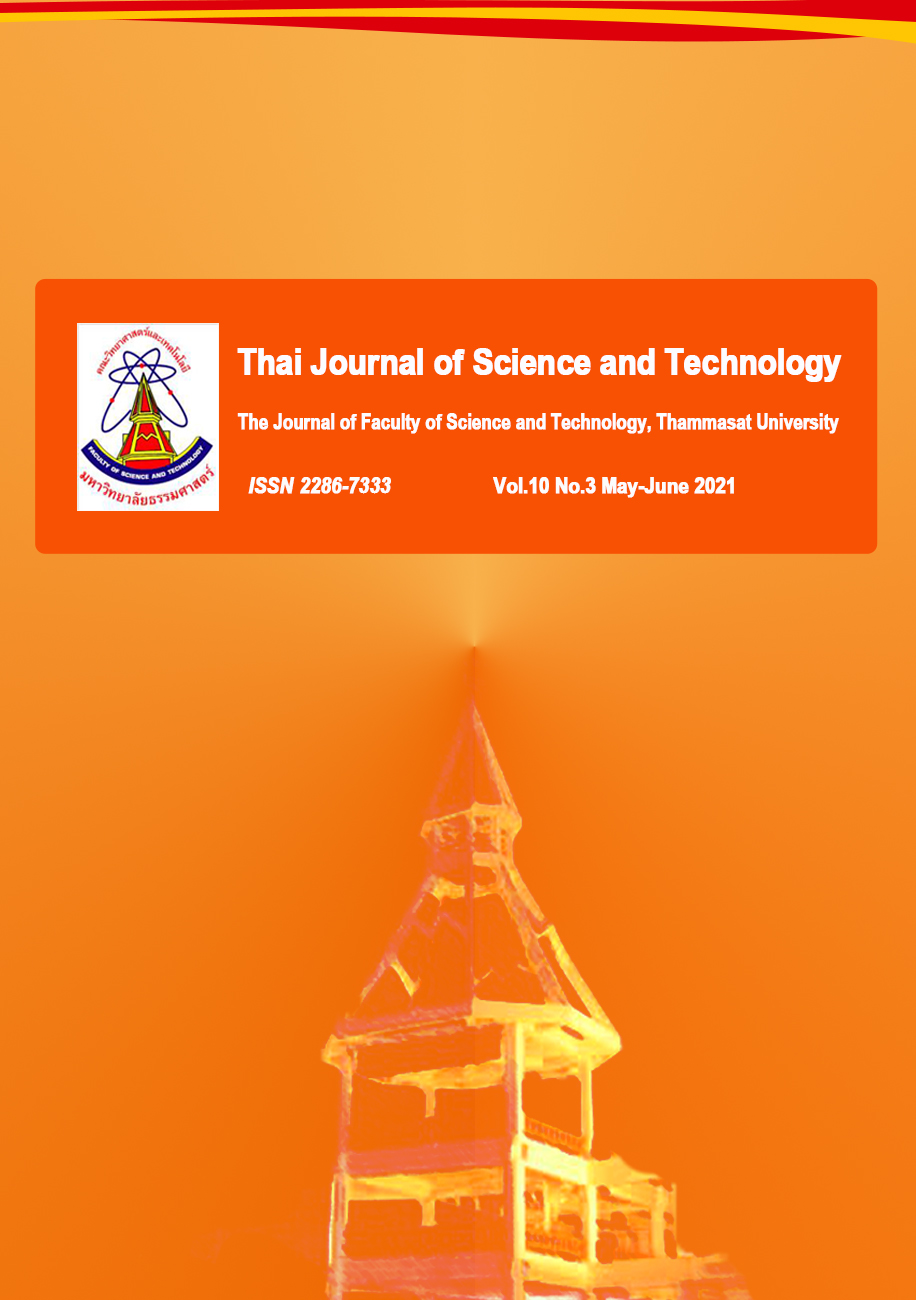Development of Fermented Bio-extract Combined with Beneficial Bacteria for Enhancing Plant Growth and Controlling of Bacterial Leaf Blight of Rice
Main Article Content
Abstract
The aim of this research was to develop the fermented bio-extract combined with beneficial bacteria for enhancing rice plant growth and controlling of bacterial leaf blight of rice. Banana plant, kaffir lime, and chili were raw materials used in fermented bio-extract. Three fermented bio-extract were tested for Xanthomonas oryzae pv. oryzae. (Xoo) inhibition using a completely randomized design (CRD). The result revealed that banana trunk fermented bio-extract showed the efficacy to inhibit Xoo with causing clear zone of 1.56±0.26 cm. Efficiency of all 3 fermented bio-extract on enhancing rice plant performance was investigated at 7 days old plant. The results showed that the chili fermented bio-extract and banana trunk fermented bio-extract were the most efficiency treatment to promote growth of rice. Root length, shoot length, root fresh weight, root dry weight, shoot fresh weight and shoot dry weight were 6.02±0.83 and 5.35±0.37 cm, 5.5±0.48 and 5.2±0.26 cm, 2.52±0.45 and 1.97±0.16 g, 0.11±0.00 and 0.11±0.00 g, 2.96±0.05 and 2.67±0.17 g, and 0.20±0.01 and 0.19±0.01 g, respectively. From the previous results, banana stem fermented bio-extract was selected for further development. Antagonistic bacterial that showed phosphate solubilization, Bacillus sp. strain PSB3-5 was added into banana stem fermented bio-extract with 1x1011 cfu/ml final concentration and keep in room temperature (32±2 ºC) for 60 days. Results showed PSB3-5 populations were 6.4x109, 3.1x108, 3.6 x108, and 3.0x108 cfu/ml at 48 h, 15, 30, and 60 days after inoculated, respectively. These results indicating possibility of combined fermented bio-extract with phosphate solubilizing bacteria for the purpose of developing biological control method to reducing the use of synthetic fertilizer and pesticides.
Article Details

This work is licensed under a Creative Commons Attribution-NonCommercial-NoDerivatives 4.0 International License.
บทความที่ได้รับการตีพิมพ์เป็นลิขสิทธิ์ของคณะวิทยาศาสตร์และเทคโนโลยี มหาวิทยาลัยธรรมศาสตร์ ข้อความที่ปรากฏในแต่ละเรื่องของวารสารเล่มนี้เป็นเพียงความเห็นส่วนตัวของผู้เขียน ไม่มีความเกี่ยวข้องกับคณะวิทยาศาสตร์และเทคโนโลยี หรือคณาจารย์ท่านอื่นในมหาวิทยาลัยธรรมศาสตร์ ผู้เขียนต้องยืนยันว่าความรับผิดชอบต่อทุกข้อความที่นำเสนอไว้ในบทความของตน หากมีข้อผิดพลาดหรือความไม่ถูกต้องใด ๆ
References
Balouiri M., Sadiki M., & Ibnsouda SK. (2016). Methods for invitro evaluating antimicrobial activity: A review. Journal of Pharmaceutical Analysis, 6, 71-79.
Booth, I.R. (1985). Regulation of cytoplasmic pH in bacteria. Microbiological Reviews, 49, 359-378.
Brown, J. C. (1963). Interactions involving nutrient elements. Annual Review of Plant Physiology, 14, 93-106.
Chen, X., Sun, Z., Meng, H., & Zhang, H. (2009). The acid tolerance association with expression of H+-ATPase in Lactobacillus casei. International Journal of Dairy Technology, 62, 272-276.
Department of Agriculture. (2004). Scientific Information Bio-extract (Part 1). Quickprint of Set Co.,Ltd. Bangkok, 51p. (in Thai)
Duncan, C. J., Bowler, K., & Davidson, T. F. (1970). The effect of tannic acid on the phosphorylation and ATPase activity of mitochondria from blowfly flight muscle. Biochemical Pharmacology, 19, 2453.
Ehiowemwenguan, G., Emoghene, A.O. and Inetianbor, J.E. (2014). Antibacterial and phytochemical analysis of Banana fruit peel. IOSR Journal of Pharmacy, 4, 18-25.
Feehily, C., & Karatzas, K. A. (2013). Role of glutamate metabolism in bacterial responses towards acid and other stresses. Journal of Applied Microbiology, 114, 11-24.
Gut, H., Pennacchietti, E., John, R. A., Bossa, F., Capitani, G., De Biase, D., & Grütter, M. G. (2006). Escherichia coli acid resistance: pH-sensing, activation by chloride and autoinhibition in GadB. EMBO Journal, 25, 2643-2651.
Grogan, D. W., & Cronan, J. E. Jr. (1997). Cyclopropane ring formation in membrane lipids of bacteria. Microbiology and Molecular Biology Reviews, 61, 429-441.
Harris, C. M. and Livingstone, S. E. (1964). Bidentate Chelates, Chelating Agents and Metals Chelates, (Dwyer, F. P. and Mellor, D. P., eds), p. 95. Academic Press, New York.
Krulwich, T. A., Agus, R., Schneier, M., & Guffanti, A. A. (1985). Buffering capacity of bacilli that grow at different pH ranges. Journal of Bacteriology, 162, 768-772.
Ma, Y., & Marquis, R.E. (1997). Thermophysiology of Streptococcus mutans and related lactic-acid bacteria. Antonie Van Leeuwenhoek, 70(2), 91-100.
Mahamud, R. (2005). Innovation in agricultural resource management for organic agriculture case study of organic rice farmers group, Amphoe Kudchum, Yasothon. Graduate School of Kasetsart University, Bangkok. (in Thai)
Mala, T. (2007). Organic Fertilizers and Biofertilizers: Production Techniques and Utilization. Faculty of Agriculture, Kasetsart University, Kasetsart University Press, Bangkok. (in Thai)
Marubodee, R., & Ruanpan, W. (2020). Effect of bioextract on growth and yield of arrowroot (Tacca Ieontopetaloides). RMUTSB Academic Journal, 8(2), 153-164. (in Thai)
Miwa, T., Esaki, H., Umemori, J., & Hino, T. (1997). Activity of H(+)-ATPase in ruminal bacteria with special reference to acid tolerance. Applied and Environmental Microbiology, 63, 2155-2158.
Rivera-Cruz, M.D.C., Narcı ́a, A.T., Ballona, G.C., Kohler, J., Caravaca, F., & Rolda ́n, A. (2008). Poultry manure and banana waste are effective biofertilizer carriers for promoting plant growth and soil sustainability in banana crops. Soil Biology and Biochemistry, 40, 3092-3095.
Sangwanna, M., Seeniang, P., & Patarapuwadol, S. (2018). Survey of bacterial blight disease and the need of knowledge in disease management in organic rice system in Roi Et province. Journal of Agricultural Science, 49(3), 230–240. (in Thai)
Shabala, L., & Ross, T. (2008). Cyclopropane fatty acids improve Escherichia coli survival in acidified minimal media by reducing membrane permeability to H+ and enhanced ability to extrude H+. Research in Microbiology, 159, 458-461.
Wouters, J.A., Frenkiel, H., de Vos, W.M., Kuipers, O.P., & Abee, T. (2001). Cold shock proteins of Lactococcus lactis MG1363 are involved in cryoprotection and in the production of cold-induced proteins. Applied and Environmental Microbiology, 67, 5171-5178.
Zavaglia, A., Disalvo, E., & Antoni, G. (2000). Fatty acid composition and freeze–thaw resistance in lactobacilli. Journal of Dairy Research, 67, 241-247.


